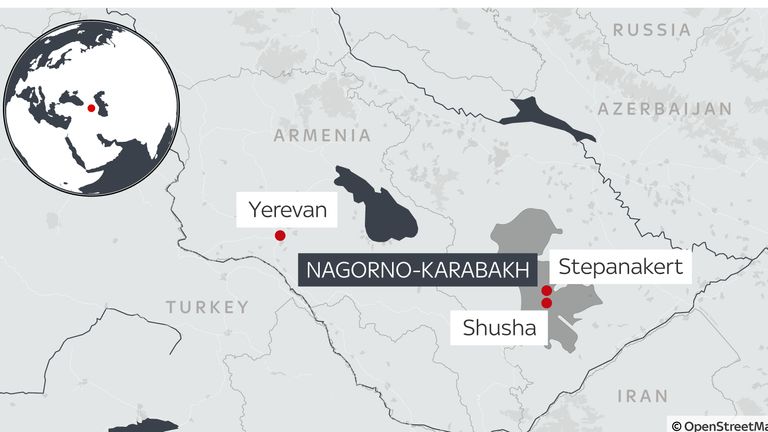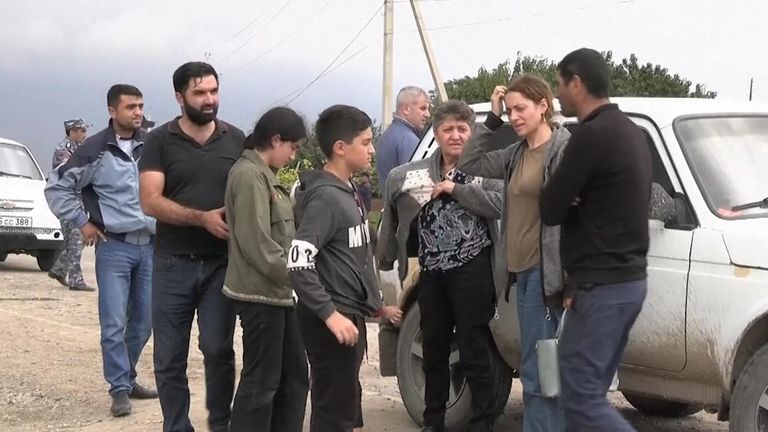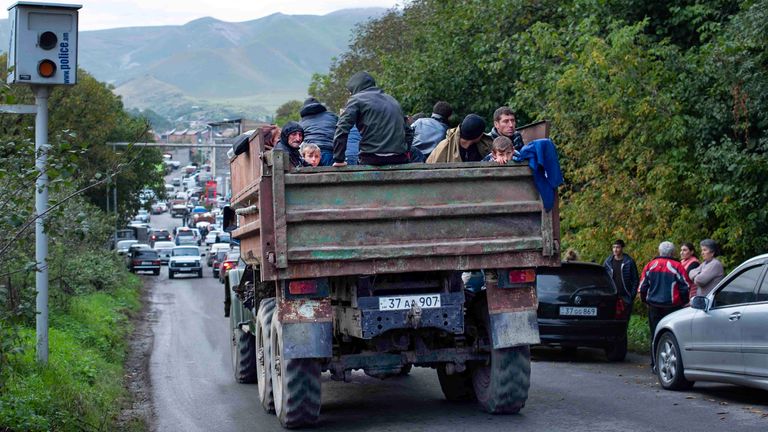As bombs fell near the city she called home on the edge of Europe, Hasmik Arzanyan ran back to her fourth-floor home one last time.
She was used to conflict in the disputed territory of Nagorno-Karabakh, with her father serving in the first war 30 years ago and her husband fighting in the second during the COVID-19 pandemic.
But Azerbaijan’s latest attack on the enclave – which had been ethnically Armenian but is recognised internationally as Azeri land – felt different to Hasmik.
The mother of two had sensed these were her final days in the region’s de facto capital of Stepanakert, and she would soon join 100,000 other Armenians on an arduous escape.
Before that mass exodus, which would signal the end of Nagorno-Karabakh’s 1,700-year Armenian presence, Hasmik left the shelter and braved nearby bombing for a final homemade coffee.
“I just couldn’t stay in the shelter, looking at the despair in people’s faces was enough to drive you crazy,” she said.
“I got home, and I just felt this was it, this was the end. I couldn’t explain why, but I felt it, these were our last days in Stepanakert.
“So when I got back home, I turned the stove on and made myself one last coffee. I just wanted to feel some peace in my home for those two minutes.”
The attack by the much larger Azerbaijani army began on 19 September and lasted 24 hours, forcing the region’s leadership to surrender and agree to dissolve its self-styled republic by January 2024.
It came after a 44-day war launched by Azerbaijan in 2020, which saw Baku regain seven surrounding territories occupied by Armenians since the first war in 1994 as well as a third of the region itself.
Azerbaijan’s September offensive went ahead despite international calls to guarantee the safety of the local population in Nagorno-Karabakh, which Armenians call Artsakh.
And with no real sign of Russian peacekeepers – stationed in the region as part of the second war’s ceasefire agreement – intervening, panic began to spread among the Armenians.
“It’s impossible to explain with words what it was like. The look on people’s faces, the crying, I don’t think I’ll ever be able to forget it,” Hasmik said.
“Everyone was in chaos, children were still in school, parents had lost their minds and didn’t know what to do. Some were crying, some were screaming, one had turned pale and wouldn’t move. There was absolute chaos all around.”
Husband’s final farewell
The Armenians had already endured acute shortages of food, fuel and medicine in a nine-month Azerbaijani blockade cutting off the region’s road connection with Armenia, the Lachin corridor.
That road had been reopened by Azerbaijan shortly before the bombs started falling, and would within days allow Armenians to leave the territory.
Hasmik packed just a few clothes and took food for her two children – Arman, 11, and eight-year-old Vartan – for the drive to Armenia, while her husband stayed, promising to send the rest of their belongings later.
She had begged Armen to leave with her and their children, but he wanted to be the last Armenian to leave the region and felt the need to help others preparing to flee. She wouldn’t see him again.
During a desperate search for fuel, some Armenians were queuing at a storage facility near Stepanakert on 25 September when a huge explosion killed more than 200 people.
“When we arrived I couldn’t speak, we didn’t have water to drink and whatever we had we rationed for our children,” Hasmik said at the end of a 32-hour drive that would normally last a fraction of that time.
“We found out there had been an explosion, they were saying there was an explosion and my husband had been seen there.”
‘There was no time to be weak’
Hasmik said she had just received messages from Armen – with no signal during the journey to Armenia – asking if they were safe and where they got to.
“I called him and called him, but there was no answer,” she said. “I didn’t believe that he was there, I said that’s not possible.”
It would have been their tenth wedding anniversary this October.
“I felt so empty without him, but there was no time to be weak,” she wrote in a journal, which she shared with Sky News, adding her children had become her strength.
During the 44-day war, Hasmik set out to bring “some happiness” to the region’s other youngsters and created a unique sand-drawing wooden tablet, which could read out well-known children’s stories for users to then visualise on the screen.
It became popular enough for regular classes and despite her original creations remaining lost in Karabakh, she has managed to revive sessions in Armenia, which she runs around her full-time job in human resources.
While all her belongings remain lost in her old home, she said this one invention was something she could bring to Armenia.
Cycle of violence and displacement
Other refugees have chosen to settle elsewhere, with some relocating to Russia, which was once seen by some Armenians in Nagorno-Karabakh as their guarantor.
With state support ending in January next year and local media reporting little more than 4,000 refugees have applied for citizenship, some believe more will choose to leave Armenia entirely.
Nearly 11,500 refugees are said to have emigrated already, as of July.
Their fate has echoes of the trauma suffered by Azerbaijanis for nearly three decades.
While Nagorno-Karabakh has a significant Armenian history, for centuries it was also home to tens of thousands of Azeris, who became internally displaced people (IDPs) following the first war.
Armenian return ‘impossible’
While Azeris have the chance to finally return, it appears unlikely they will be joined in the foreseeable future by Armenians, many of whom fear living under an Azerbaijani government.
The country consistently ranks as one of the least free states in the world and is currently detaining activists who are critical of the government, in a crackdown criticised by observers such as Amnesty International.
Reporters Without Borders ranks Azerbaijan 164th on its Press Freedom Index – lower than Russia and Venezuela – while democracy watchdog Freedom House considers the country “not free”.
Meanwhile Azerbaijan’s autocratic president Ilham Aliyev, who replaced his late father in 2003, has frequently used anti-Armenian rhetoric.
In a speech in December 2022, he said Armenia – referred to as “Western Azerbaijan” – “was never present in this region before” and “present-day Armenia is our land”.
Azerbaijan’s Ministry of Foreign Affairs has not responded to Sky News’s request for comment.
The prospect of Armenians returning is “impossible at this present moment”, according to Tigran Grigoryan, the head of Regional Center for Democracy and Security, a Yerevan-based thinktank.
“People need to understand we are dealing with one of the most violent and vicious political conflicts, not just in the post-Soviet space but in the world, I think,” he told Sky News
“It’s impossible for the civilian population to live under Azerbaijani governance without some kind of international guarantee – this is not about good and bad, this is the history of the conflict.”
There is deep mistrust between Armenians and Azerbaijanis over the region spanning generations, meaning many are not persuaded by Baku’s assurance all residents can return to live in peace.
“Azerbaijan says they are ready to take in the civilian population, but on the ground they’re destroying houses,” Tigran said.
“As long as there are no solid international guarantees that could secure the future of the population, all this talk about willingness is propaganda.”
‘Abandoned by world’
The Armenian government is addressing short-term challenges, but the biggest issues are employment and long-term integration, Tigran added.
The job market is mainly concentrated in and around the capital, where housing is most expensive, and the border regions offer few opportunities.
“Armenia’s government hasn’t been successful in raising awareness and funds internationally,” Tigran said.
For years, the Nagorno-Karabakh issue has been referred to as a frozen – or forgotten – conflict, and while it has garnered more attention since the second war, there remains a sense among Armenians they have been abandoned.
This lack of international action has been the biggest factor, Tigran said, both in terms of domestic support and accountability for Azerbaijan’s military offensive.
“We are dealing with an extraordinary emergency and the support has been miniscule,” he said.
“The predominant feeling among refugees is they feel abandoned from all governments.”
Yuri Kim, a senior official at the US State Department, told a Senate Foreign Relations Committee “we will not tolerate any attack on the people of Nagorno-Karabakh” just days before Azerbaijan’s offensive.
Read more:
Call for PM’s resignation after villages handed to Azerbaijan
Russia sanctions-busting? Questions remain over UK car exports
Statements like that “have not corresponded to the reality”, Tigran said, and it has been “business as usual” with Azerbaijan, which hosts global climate summit COP29 in November.
Hasmik, who speaks English and French as well as Armenian, said she felt “forgotten” by the rest of the world.
“The blockade was incessant for us. We struggled, we persevered, but for nine months it was horrible. People lived here, but the world stayed silent, as if nothing was happening to us,” she said.
“As people, we are all supposed to be born with human rights. But if you’re born in Artsakh, are you not a person?”











Leave a Reply